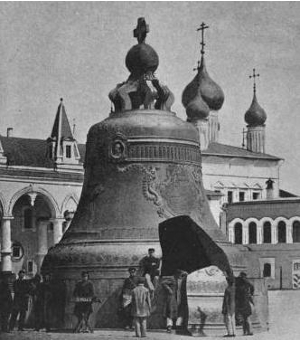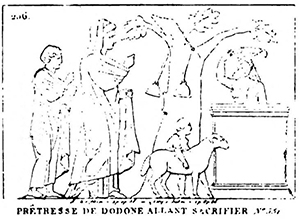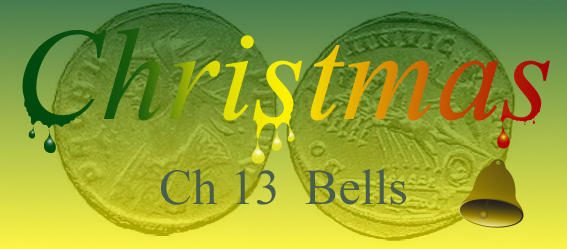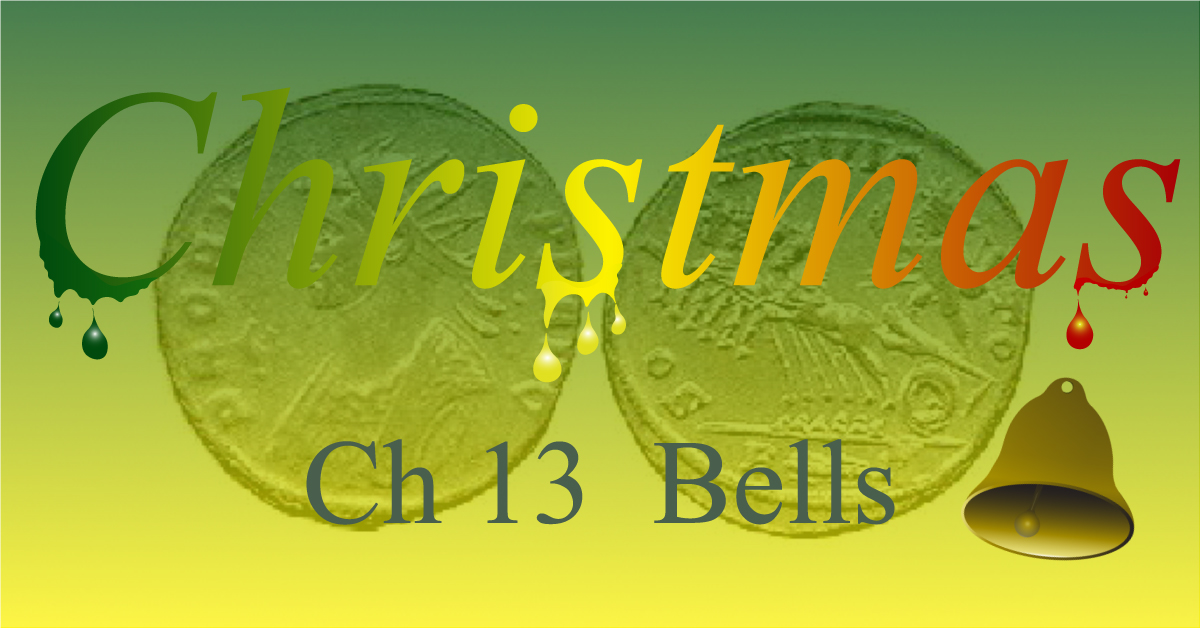The toll of the bell reverberates continuously through the centuries. We will begin our journey by climbing through the pages of the Bible to show a clearly Biblical use of the bell. At the top of our ascent, we will find the end of history; we will see bells used in prophecy to mark the pinnacle of human existence. Then, we will see the deceiver use the bell to seat the masses. We will watch as they are prepared for their journey down the slippery slope. And, they are off! The bell rings marking their transgression against the Christ. The glistening slope has been polished by generation after generation who have each taken their turn on a descent through the unbiblical. The masses rapidly pick up speed as they race down the slippery, shining, spiraling sheet of pagan notes. Finally we will watch as they plunge off the end of the ride and fall headlong into the waiting rays of the sun.
The bell’s tempting tinkling pulsates through the pages of history alongside the priests, kings, and peasants who have used it. Our very own Bible shows bells can be used in a manner acceptable to God. The Bible mentions bells in at least five verses (see Exo 28:33, Exo 28:34, Exo 39:25, Exo 39:26 and Zec 14:20). These verses clearly show bells can serve a purpose which is acceptable to God. The bells were attached to the priestly garments not as an object of worship but as an object of purpose. Exodus 28:2 tells us they were made for glory and beauty. Exodus 28:35 tells us the purpose of the bells was so the priest could be heard when he went into the Holy place before the LORD. The most important thing to remember about the use of bells on the priestly garments is the LORD commanded they be used in this manner (see Exodus 39:26). God commanded it. Therefore, their use in this manner was acceptable to Him. We do not get to choose how we worship God. God chooses what is acceptable to Him. This principle can be made no clearer than it is in Leviticus 10:1 through 10:3.
Lev 10:1 And Nadab and Abihu, the sons of Aaron, took either of them his censer, and put fire therein, and put incense thereon, and offered strange fire before the LORD, which he commanded them not.
Lev 10:2 And there went out fire from the LORD, and devoured them, and they died before the LORD.
Lev 10:3 Then Moses said unto Aaron, This is it that the LORD spake, saying, I will be sanctified in them that come nigh me, and before all the people I will be glorified. And Aaron held his peace.
The midnight mass on Christmas Eve is a purely pagan practice which is intimately tied to sun worship.
We are not told exactly what Nadab and Abihu offered to the LORD. We are simply told it was strange. It was foreign. They offered something other than what God had commanded them to offer, and they paid for it with their lives. This is symbolic of what will happen on judgment day to those who may believe they are doing the will of God but who are not truly doing the will of God. We are told this in Matthew 7:21 through 7:23 and again in Luke 13:24 through 13:28.
Mat 7:21 Not every one that saith unto me, Lord, Lord, shall enter into the kingdom of heaven; but he that doeth the will of my Father which is in heaven.
Mat 7:22 Many will say to me in that day, Lord, Lord, have we not prophesied in thy name? and in thy name have cast out devils? and in thy name done many wonderful works?
Mat 7:23 And then will I profess unto them, I never knew you: depart from me, ye that work iniquity.
Luk 13:24 Strive to enter in at the strait gate: for many, I say unto you, will seek to enter in, and shall not be able.
Luk 13:25 When once the master of the house is risen up, and hath shut to the door, and ye begin to stand without, and to knock at the door, saying, Lord, Lord, open unto us; and he shall answer and say unto you, I know you not whence ye are:
Luk 13:26 Then shall ye begin to say, We have eaten and drunk in thy presence, and thou hast taught in our streets.
Luk 13:27 But he shall say, I tell you, I know you not whence ye are; depart from me, all ye workers of iniquity.
Luk 13:28 There shall be weeping and gnashing of teeth, when ye shall see Abraham, and Isaac, and Jacob, and all the prophets, in the kingdom of God, and you yourselves thrust out.
Zechariah 14:20 speaks of bells on the horses at the coming of The LORD. We will not delve into the symbolic meaning of this verse and those surrounding it. However, we know this chapter is dealing with the coming of The LORD because it specifically tells us this is the case in verses Zec 14:1, Zec 14:5, and Zec 14:9.
Throughout history, bells have served very important roles. Before the telephone, email, and the internet, the bell was a means of communication between towns and also between the church and the congregation. The church bell has long been used to remind people to pray. Even in certain places today, the church bell is rung three times a day as a means to remind people to pray. This is based upon Jewish tradition and a couple of Bible verses such as Psalms 55:17 and Daniel 6:10 which indicate prayer at three times throughout the day, though the use of bells to signal prayer is not mentioned in the Bible. Praying at least three times a day is a good thing, but perhaps when we place specific times of the day for that prayer to occur, prayer becomes work rather than part of a relationship.
As the bell can be used to remind people to pray, it can be used to mark un-Godly acts as well. As an example, let us look at the practice of ringing a bell at the moment of consecration, which is a tradition engaged in by some congregations. There are those who believe the bread and the wine consumed during communion are actually the real flesh and blood of Christ. Those who believe this refer to the moment the bread and wine are turned into "flesh and blood" as the moment of consecration. The process by which the bread and wine are supposedly turned into flesh and blood is called transubstantiation. We can go to the Catholic Education Resource Center's website to gain a better understanding of this concept.
The most solemn moment of the Holy Mass is the consecration. Up to that moment what is on the altar is bread and wine. From the moment when the priest pronounces the words of the consecration 'This is my body'; 'This is the cup of my blood' what is in the altar is the body and blood of Jesus Christ. Of the bread and wine nothing remains except the appearances. But, under those appearances, God is really present. All of this is done by the power of God. Jesus Christ is God become Man and he can do anything. He can even change a little bread and wine into his own body and blood so that it can be our offering and sacrifice: and also, if we are fit to receive him, so that it can be our food.
The priest raises the host and the chalice. And we adore Appearances will not deceive us if we have faith. With the eyes of our body we only see bread. But with the eyes of faith which is how the Christian soul sees we see and recognize our Lord himself. Let us express our faith. You remember those words of Saint Thomas, 'My Lord and my God.' Many people repeat them quietly to themselves at the moment of the elevation. Thomas wished to see the glorious Body of the risen Jesus. Then he proclaimed his divinity. Our Lord said to him, 'Thomas, you believe because you can see me. Happy are those who have not seen and yet believe.' Let us proclaim our faith in the real presence of Jesus in the host, relying for proof on his infallible word.
Consecration Communion
This is the moment of the Mass when we have to be most awake, putting heart and soul into many acts of faith and love and adoration. Because Christ is at last on the altar. There is no longer any bread or wine. By the miraculous process of transubstantiation all of it has been changed into the body and blood of Jesus Christ, God become Man. Our Lord is really present with his humanity and his divinity, offering himself for us on the altar just as he offered himself for us on the cross.
We are on Calvary. This is the 'composition of place' that we should make in these moments. Christ is offering himself for us. We too should want to be beside him, like our Lady and Saint John who were beside him and kept him company on Calvary. Let us ask them to help us not to get distracted, to be present with faith, to realize what Jesus is doing as he offers himself on the altar for the whole humanity to adore him, to thank him.
The Mass is never a private action. Even if very few people or only a single person accompanies the priest, the whole Church is present. 'Priests fulfill their chief duty in the mystery of the Eucharistic sacrifice. In it the work of our redemption continues to be carried out. For this reason, priests are strongly urged to celebrate Mass every day, for even if the faithful are unable to be present, it is an act of Christ and the Church.'4 Let us be conscious of this presence of the whole Church which, of course, also includes the angels and the saints. They are present and adoring from the moment of the consecration. If we ask them, they will help us too, to be present in a spirit of reverence and adoration" (Burke "Mass") .
As we have seen in this quote, Christ is sacrificed over and over in the minds of those who participate in this version of the communion rite. The idea of Christ being sacrificed over and over is in violation of the very word of God which tells us our Christ offered Himself up once.
Heb 7:27 Who needeth not daily, as those high priests, to offer up sacrifice, first for his own sins, and then for the people's: for this he did once, when he offered up himself.
Heb 9:26 For then must he often have suffered since the foundation of the world: but now once in the end of the world hath he appeared to put away sin by the sacrifice of himself.
In the transubstantiation version of communion, the adoration for Christ is transferred to the bread and the wine. What was intended by Christ to be symbolic, becomes pagan through transference. No longer is the Christ worshiped, but now the bread and the wine become viewed as Holy and take His place. Forms of the Christian church, in times past, have burned many a person at the stake for refusing to believe in this unholy and un-Biblical principle. On the issue of transubstantiation alone, have the saints willingly given their lives. Yet today, it is widely accepted without much thought being given to whether the concept is right or wrong. The masses willingly submit themselves to this idolatrous act, and they often mark the moment of their transgression by the ringing of a bell.
As the bread steals the adoration of Christ in the example of transubstantiation, so do many other idolatrous rituals associated with Christmas. Should we need a tree, or lights, or other decorations to remind us of Christ when we are, in fact, in the public place of worship? Everything in the sanctuary serves a purpose. For what purpose is an idol with pagan roots placed in the Sanctuary? To what does the toll of a bell remind us when we are already engaged in worship at the public sanctuary? What can that ringing bell do to bring us closer to Christ when we are already at His feet? The answer is apparent. The bell can only distract in the same manner the tree and the lights distract: through one of the five senses or emotion. In the old temple in Jerusalem, bells were indeed worn by the priest in the temple. There was also a real lamb placed upon the altar. This was a physical representation of the plan of salvation. As the lamb was a symbol then, so is the bread and the wine a symbol now. The lamb was no more Christ then than the wafer and wine are Christ now. Perhaps the bell has a role to play in the sanctuary today, as it did then, but surely it cannot be to mark the moment of confluence between Christ and idolatry at the instant of transference and "transubstantiation."
During the course of man’s existence, he has continuously incorporated the bell into his religious operations. Man has constantly associated the bell with greatness and especially buildings of great significance. Perhaps this is a case of pagans attempting to equate their temples to the temple of God and their gods to The God. The tinkling of bells is said to have appeased thunderous Jove (Jupiter). Since an idol of stone can feel no jealousy, perhaps his followers felt it for him and incorporated the bell into their religious ceremonies. Perhaps they associated the jingling at the hem of God’s priest with the power of The God, when in truth, the power which jingled these bells was the trembling of feet serving the One and Only Living God. In the next quote, we see Augustus was the first to hang bells in the temple of Jupiter. He did this because bells were “commonly hung at the gates of great houses.”
[*Jupiter Tonans (Jupiter) was the spirit or so-called power believed to be presiding over the temple of Jupiter on the Capitoline Hill. The moniker Jupiter Tonans is equal to Thundering Jove.]" (Suetonius 136).
We have already seen many of the pagan rituals surrounding Christmas entered main stream Christianity through the fourth century church at Rome. We can add the use of the church bell in Christianity to this growing list of pagan influence brought to us at the hand of the Roman Church at roughly the same time.
Pope Sabinian is said to have sanctioned the use of the bell about two hundred years later.
This quote also tells us a ceremony was established during which the bells were blessed. The act of blessing a bell is idolatrous in itself. Blessing is a very important Biblical concept which must be respected. The first three things God blessed are animals, man, and the seventh day. These three blessings all take place within the first two chapters, but the Bible is full of blessings. Words like bless, blessed, blessing, and blessest are used over five hundred times in the King James Bible. God is blessed, nations are blessed, people are blessed, the Sabbath is blessed, food, drink, land, communion, the earth, and sacrifices are blessed. But, objects are never blessed. The only time an object is mentioned as being blessed is when the act of blessing an idol is used as an example of abominable things (Isa 66:3). The blessing of a bell is the blessing of an idol. In the blessing of a bell, the focus is directed toward the bell. After the blessing, the bell was thought to possess some sort of power. The focus and admiration was directed toward the bell rather than God. This becomes obvious in the following quote where we are told the bells were given names during a ritual in which the bell was "baptized."
Notice this quote tells us the bell was named after a "saint" so the people might think this "saint" was somehow communicating with them through the ringing of the bell. This is nothing less than church sanctified communication with the dead. The Bible calls a person who engages in this practice a necromancer. We are told this is considered an abomination by God.
Deu 18:10 There shall not be found among you any one that maketh his son or his daughter to pass through the fire, or that useth divination, or an observer of times, or an enchanter, or a witch,
Deu 18:11 Or a charmer, or a consulter with familiar spirits, or a wizard, or a necromancer.
Deu 18:12 For all that do these things are an abomination unto the LORD: and because of these abominations the LORD thy God doth drive them out from before thee.
These "baptized" bells were used by the church to "scare away devils." As we read in this next quote, the belief of those Christians who followed the teachings of the Pope was only the bells which were baptized had the power to scare away devils.
The Golden Legend mentioned in that quote was a compilation of the lives of saints. It was a very influential book in the later part of the Middle Ages. It was written by Jacobus de Voragine, Archbishop of Genoa during the thirteenth century, translated into English by William Caxton about 1483, and printed by Wynkyn de Worde during the sixteenth century. The quote from the Golden Legend may be a little hard to read because of when it was written. It basically tells us the people of the time believed evil spirits were afraid of the ringing of bells. It goes on to say they rang bells during bad weather because they believed this would scare away wicked spirits which they thought caused thunder and other severe weather.
Christians have also used the bell in a death ritual called the passing bell. As we will see in the next quote, the passing bell was rang at the moment a person died. This was done for two purposes. First, the bells were thought to demonstrate the prayers of all good Christians for the person who had just died. Secondly, people believed evil spirits somehow attacked the dead person's soul, and by ringing bells these attacking evil spirits would be driven back which would allow the dead person's soul a head start on its journey.

(Allen 40)
The bigger the bell the better it was believed to have been at scaring away evil spirits. This is part of the reason why some bells are of such enormity. The largest of which is the massive, but broken, Tsar Bell in Russia which weighs over 445,000 pounds. The bell is topped by a large yellow cross and has a likeness of Christ and Mary engraved upon it. This may be of some importance because those who openly and knowingly engage in the occult believe the purpose for a bell is influenced by the color or material from which it is made. There is absolutely nothing Biblical about any of these supposed Christian uses of the bell. These practices demonstrate the substantial infiltration of superstitious, pagan ideas into the church.
The bells used at Christmas are also tied to pagan worship including sun worship. One of the most recognizable Christmas rituals involving bells is the tolling of the bell on Christmas Eve in preparation for midnight mass. The midnight mass on Christmas Eve is a purely pagan practice which is intimately tied to sun worship. Midnight of the winter solstice is when the sun reaches its very lowest point below the horizon. Sun worshippers traditionally gathered together and used the position of the star Sirius to mark this event. The low point of the sun’s descent is the apex in Mithraism because sun worshippers believe this is the moment the sun is reborn. This is the so-called birth of the Sol Invictus.
One may find a connection to Mithraism in the very name bell. The etymology of the word bell tells us bell is the sun which was worshipped by the Chaldeans and the Assyrians.
How the bell was used in ancient rituals at the winter solstice is not fully known, although we may gain some insight by looking at a possible precursor to the bell called the sistrum. The sistrum was a type of rattle used in ancient Egypt. There are numerous ancient images of Nefertiti and Meritaten shaking their sistra beneath the sun disk (Tyldesley "Hwt-Benben"). Plutarch tells us the sistrum was used to stir things back into motion and its effects were particularly connected to the realm of the moon.
The use of sistrum in worship of the sun is evident. Based upon Plutarch’s words, one could surmise the use of the sistrum at the winter solstice was designed wake the slumbering sun which was seen as succumbing to deadly forces. By rattling the sistrum, worshipers may have believed they were helping to rejuvenate the sun and stir it back into motion.
The term solstice bells is known in our time but is absent from many of the historical records where one would expect to find it. This could very well be a case of modern heathenism becoming main stream in our time. The use of solstice bells in connection with Christmas today is apparent. For example, track number fourteen on the 2003 album titled The Jethro Tull Christmas Album is a song titled Ring Out, Solstice Bells. This song is packed with pagan lyrics including praise for the sun.
joyful as the silver planets run.
Seven maids move in seven time.
Sing the song the bells call, loudly chiming.
Ring out those bells.
Ring out, ring solstice bells.
Ring solstice bells." (Anderson "Ring").
Today, there are those who admittedly ring so-called solstice bells, but for the most part, these bells are called New Year's bells and Christmas bells. The following excerpt is taken from a poem which was penned in the early 1800's and shows Christmas bells were in use at that time.
Gave honour to the holy night;
On Christmas eve the bells were rung;
On Christmas eve the mass was sung" (Scott 71).

Christmas bells were likely in use during the fifth century since, as we have seen, bells were in use by the church in Rome at that time. Bells have also been used to "ring in the new year" for a very long time. When this started is hard to tell, but we can find the phrase in court records from the middle of the seventeenth century. Therefore, the practice was well established by then and probably much earlier.
Some sources claim there were bells in use at the Saturnalia. We can be fairly certain bells did indeed play a part in the Saturnalia because their use is attributed to the cults of Cybele and Attis. According to the Encyclopedia of Religion and Ethics, Pagan cultures around the world have used the bell to summon followers to religious services since antiquity much like they are used to call some Christian sects today. The same article shows the cults of Cybele and Attis used bells in their religious rites and points to this sketch of a bas relief as part of the evidence (Chamberlain 313-14). Two bells are visible hanging from an oak in the relief which is said to depict a sacrifice to Attis. Cybele and Attis are connected to Christmas and are deeply intertwined with sun worship. The next chapter is devoted to an in-depth analysis of these two pagan deities. The Aeruscatores were priests of Cybele, and they used bells in their religious duties.
This description of the Aeruscatores' ringing bells while asking for money for their cult must surely bring to mind an occurrence we are all too familiar with today. With certain regularity, the Christmas season will be ushered in by people ringing bells in hopes of attracting a giving hand to their hanging red buckets in support of their church. The Salvation Army is part of the Universal Christian Church.
As stated at the beginning of this chapter, there is nothing inherently wrong with bells. Our actions while using bells is either Godly or evil. The bell itself is simply a thing; the bell is only an object which can do neither good nor bad. It cannot speak or cause one single grain of sand to be moved out of place. However, the moment we baptize a bell, give it a name which represents a dead person we wish to communicate with, or attribute any kind of power to it, the bell becomes an idol. We would be wise to carefully examine the use of bells in any religious ceremony since the use of bells in religious ceremonies is so often of a pagan nature.
Religious Reverberations or Pagan Participation?
1. The Bible shows bells can be used in a manner acceptable to God.
2. God called for the use of bells in specific instances related to the priestly garments.
3. The Bible shows there can be deadly consequences when people decide for themselves what is acceptable to God rather than following His direction.
4. The Bible uses bells symbolically in the book of Zechariah pertaining to events at the coming of The LORD.
5. Sometimes bells are used to remind people to pray and to signal the beginning of services.
6. Bells are sometimes used to mark un-Biblical acts.
7. Pagans hung bells at the gates of places they deemed important and in the temples of their gods.
8. The use of bells for religious purposes was introduced to Christianity through the fifth century church at Rome.
9. Blessing a bell is idolatrous.
10. The blessing of an object is used as an example of an abominable act in the Bible.
11. The inclusion of bells in religious services has almost always been pagan and superstitious in nature. Examples include baptized bells and passing bells.
12. Midnight mass on Christmas Eve is a relic of sun worship.
13. The ancient Egyptians used rattles in their worship of the sun. This may be the precursor to Christmas bells.
14. Solstice bells may be a modern pagan invention.
15. The use of solstice bells in connection with Christmas today is apparent.
16. The cults of Cybele and Attis used bells in their religious rites.
17. Bells are neither good nor evil. They are simply objects. However, our use of bells can be evil.
18. Wisdom dictates caution when deciding whether or not to add bells to one's religious operations.
Since we have, for the first time in this writing, come across the name of Cybele, this seems like an appropriate time to begin learning about her.








